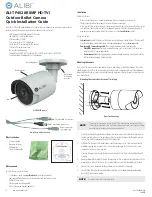PerkinElmer Optoelectronics
6
4.1.1 Master Mode
The master mode is a stand-alone operating mode that requires only DC power
for operation. Master mode is selected on the bank of DIP switches on the back of
the camera. For mode selection see section 6.4.1 on page 18.
Figure 3 Master Mode Timing
The exposure time in master mode is determined by the line period that is fixed at
N+41 clock cycles, where N is the number of pixels. See Table 1 on page 8 for
line period definition
4.1.1.1 Data Output
The analog video is output together with three synchronization signals: Camera
Clock (CCLK), Line Enable (LEN) , and Camera Line Transfer (CLT). The
falling edge of the internally generated CLT signal indicates the start of a line
readout sequence and may be used by the user’s system for controlling strobes,
shutters or other accessories. The LEN signal brackets the valid analog video that
is output in synchronization with the CCLK. LEN goes high 1 CCLK period
before the first valid pixel and goes low 1 CCLK period prior to the last valid
pixel.
4.1.2 Slave Mode
The slave mode allows the synchronization of the camera operation with a user
generated master clock MCLK and a user controlled exposure period. Slave mode
is selected on the bank of DIP switches on the back of the camera. For mode
selection see section 6.4.1 on page 18. When operating in the Slave Mode, the
user supplies LR (Line Reset), LT (Line Transfer) and MCLK (Master clock)
signals. The MCLK may be selected between 20 kHz to the maximum clock rate
allowed for the selected camera. In this mode, the camera output signals CCLK,
CLT and LEN are synchronized to MCLK to assure a locked video output. For
Slave mode timing, see Figure 4.


















